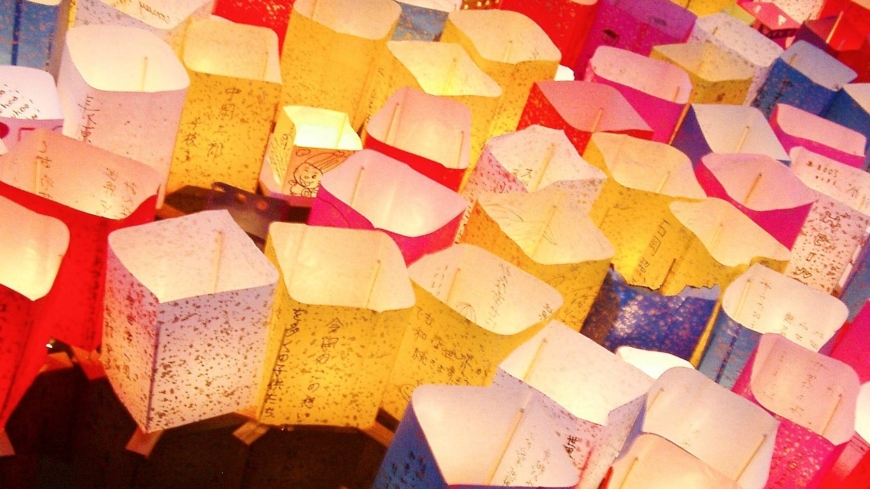Tampa, Florida – For author Shaw Kuzki, born in 1957 and raised in Hiroshima, one of the two Japanese cities devastated by the atomic bombing of August 1945, preserving and honoring stories from a harrowing past was a driving force.
“Most of my classmates (grew up) were second generation survivors,” says Kuzki. “Some of them grew up listening to many stories about the bombing, while others heard almost none because the memories were too painful. … But when you left the city or the prefecture, you could really feel that the memories of the tragedy were only common to us. After moving to Tokyo to study, I felt that I had to somehow pass these memories on to others. “
Soul Lanterns by Shaw Kuzki
Translated by Emily Balistrieri
176 pages
DELACORTE PRESS
The author writes for both children and adults in a variety of genres, but it’s her hometown stories that have resonated the most with readers. “Soul Lanterns”, Kuzki’s middle class novel from 2013, has won several awards in Japan and has been included in the White Ravens catalog, an annual list of recommended children’s literature from the International Youth Library in Germany. Beautifully translated by Emily Balistrieri and published in English by Delacorte Press last spring, Soul Lanterns is set 25 years after the historic Hiroshima and Nagasaki bombings to help members better understand the survivors and reclaim their stories.
By framing the novel from the perspective of the second generation, Kuzki invites the reader to approach the tragedy like schoolchildren do with serious curiosity and compassion.
“It’s such a well-structured novel – you learn a lot of historical details by reading it, but it’s also very emotional with the different families and their stories,” says Balistrieri. “The perspective of a 12-year-old living many years after the bombing and trying to get her outrageousness in her head is akin to how many people feel today. The atomic bombs were so long ago it was hard to believe. But when you look at the details and hear stories from people who were there, the tragedy becomes palpable. “
At the center of “Soul Lanterns” is Nozomi Ota, who realizes that every year during the Bon Festival in summer, her mother releases one of the paper lanterns into the river – which welcomes the spirits of the dead back into the world of the living – didn’t write a name on it. Nozomi’s curiosity about her mother’s untold story deepens when she starts middle school. When Nozomi and friends discover that their art teacher lost his fiancée in the Hiroshima bombing, they wonder about the past and how it relates to the present. To rediscover their story, the children suggest making Hiroshima: Then and Now the theme of the school’s annual cultural festival and begin looking for stories from members of their community. This simple plot structure enables Kuzki to weave several personal stories from the bombing and its aftermath into the main narrative.
Despite the serious subject matter, the tone of the novel remains light. Kuzki sprinkles everyday aspects of Japanese culture throughout the text, in addition to historically accurate details and references to contemporary figures such as the Franco-Japanese painter Leonard Tsuguharu Foujita (1886-1968). “I wanted to portray the calm but irreplaceable thoughts and daily life so that readers would see Hiroshima’s problems as their own, not something from the distant past,” says Kuzki. It is in the simple details of daily life and loss in which we can best relate to a tragedy of such terrible proportions.
Kuzki says she always “writes in the hope of being translated” as sharing the memories of Hiroshima became especially important to her after moving to Tokyo to study at Sophia University and the extent of discrimination against Hibakusha (atomic bomb survivors) recognized and their descendants. For Kuzki, storytelling is a powerful way to spread awareness and clear up misunderstandings.
“I always think that the really important things should be said in a low voice often, without ever giving up. So instead of screaming about the damage to Hiroshima and being against nuclear weapons, I hope that I can continue to calmly but persistently address these issues in my stories, ”she says.
There are many such moments of subdued persistence in the novel: the gorgeous descriptions of the Hiroshima Prefecture Industrial Promotion Hall, which was once a symbol of the city’s cultural sophistication, but is now the distinctive, skeletal dome that serves as a powerful monument to the city’s tragedy; or the sober confirmation from Nozomi’s mother that “there are still so many people looking for someone in Hiroshima”. The simplicity of Kuzki’s prose illuminates her theme – “On the trail of the light of the lost”.
In Japan, “Soul Lanterns” and several of Kuzki’s other stories about Hiroshima have been recognized as a child welfare asset. By translating the novel into English, Kuzki hopes to keep memories of the lost alive and to change the reader’s perspective beyond Japan.
“When I read comments like ‘We never learned this in school’ or ‘This is the first time I’ve realized how much the people of Hiroshima suffered during the bombing and for a long time afterwards,’ I’m so happy that we were released the book in English, ”says Kuzki. “For English readers, nothing makes me happier as a writer than reading with that kind of compassion.
“Passing on negative memories means refusing to repeat the same mistakes in the future. We remember what happened to Hiroshima to keep our duty of vigilance so that we never create the same tragedy again. Reflecting on the Hiroshima tragedy is also an act of keeping in our hearts the victims – some who have become numbers whose names we don’t even know – and therefore truly mourning them. “
In a time of misinformation and too much information, Quality journalism is more important than ever.
By subscribing you can help us get the story right.
SUBSCRIBE NOW



